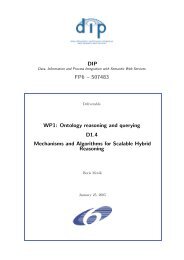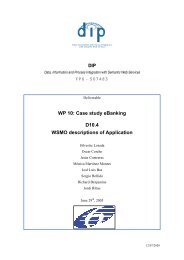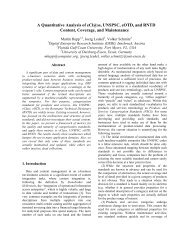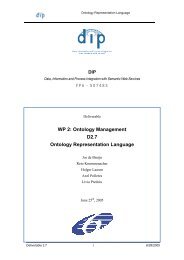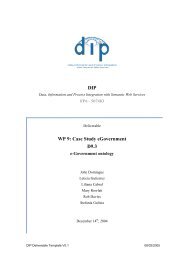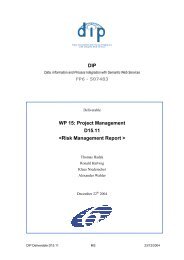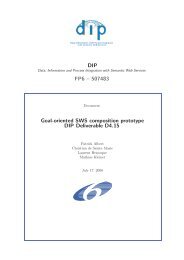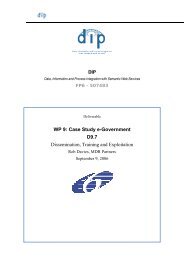Semantic Execution Environment (SEE) - DIP - Semantic Web
Semantic Execution Environment (SEE) - DIP - Semantic Web
Semantic Execution Environment (SEE) - DIP - Semantic Web
You also want an ePaper? Increase the reach of your titles
YUMPU automatically turns print PDFs into web optimized ePapers that Google loves.
<strong>DIP</strong><br />
Data, Information and Process Integration with <strong>Semantic</strong> <strong>Web</strong> Services<br />
FP6 - 507483<br />
Deliverable<br />
WP 6: Architecture & Interoperability<br />
D6.12<br />
<strong>Execution</strong> <strong>Semantic</strong>s for <strong>Semantic</strong>s-Enabled Systems,<br />
Standardisation activity with OASIS<br />
John Domingue<br />
Barry Norton<br />
Omair Shafiq<br />
Maciej Zaremba<br />
Brahmananda Sapkota<br />
Matthew Moran<br />
June 30 th , 2006<br />
11/07/2006
<strong>Execution</strong> <strong>Semantic</strong>s for <strong>Semantic</strong>s – Enabled Systems,<br />
Standardization activities with OASIS<br />
SUMMARY<br />
The <strong>DIP</strong> Architecture strives to provide guidelines for a <strong>Semantic</strong> <strong>Web</strong> Services<br />
execution platform enabling dynamic discovery, mediation and invocation of <strong>Semantic</strong><br />
<strong>Web</strong> Services. It is an architecture based on loosely-coupled services following the<br />
principles of Service Oriented Architecture where interactions between the services are<br />
not by any means predefined but can be specified during the system exploitation.<br />
The content of this deliverable is also that of the emerging deliverable of the OASIS<br />
Technical Committee for <strong>Semantic</strong> <strong>Execution</strong> <strong>Environment</strong>s (<strong>SEE</strong> TC) titled “<strong>SEE</strong><br />
<strong>Execution</strong> <strong>Semantic</strong>s”. This OASIS deliverable is being driven by members of the <strong>DIP</strong><br />
consortium and is still in an initial state. We deliberately limit this <strong>DIP</strong> deliverable so<br />
that it is aligned with the, albeit early, work of the <strong>SEE</strong> TC.<br />
<strong>Execution</strong> semantics are formal descriptions of the operational behaviour of the <strong>DIP</strong><br />
architecture. By separating the description of the system behaviour from the system’s<br />
implementation, we aim to achieve greater flexibility in how the implementations of the<br />
<strong>DIP</strong> architecture can be used and avoid the necessity to rebuild the system in the event<br />
of a new or changed requirement on how the system should operate.<br />
Disclaimer: The <strong>DIP</strong> Consortium is proprietary. There is no warranty for the accuracy<br />
or completeness of the information, text, graphics, links or other items contained within<br />
this material. This document represents the common view of the consortium and does<br />
not necessarily reflect the view of the individual partners.<br />
i 16/07/2004
<strong>Execution</strong> <strong>Semantic</strong>s for <strong>Semantic</strong>s – Enabled Systems,<br />
Standardization activities with OASIS<br />
Document Information<br />
IST Project<br />
Number<br />
Full title<br />
Project URL<br />
Document URL<br />
EU Project officer Kai Tullius<br />
FP6 – 507483 Acronym <strong>DIP</strong><br />
Data, Information, and Process Integration with <strong>Semantic</strong> <strong>Web</strong> Services<br />
http://dip.semanticweb.org<br />
Deliverable Number 6.12 Title <strong>Execution</strong> <strong>Semantic</strong>s for <strong>Semantic</strong>s-Enabled<br />
Systems - Standardisation activities with<br />
OASIS and W3C<br />
Work package Number 6 Title Architecture and Interoperability<br />
Date of delivery Contractual M 30 Actual 17-June-06<br />
Status Version. 0.01 final <br />
Nature<br />
Dissemination<br />
Level<br />
Prototype Report Dissemination Ontology <br />
Public Consortium <br />
Authors (Partner)<br />
Responsible<br />
Author<br />
Matthew Moran (NUIG), Brahmananda Sapkota (NUIG), John Domingue<br />
(OU), Barry Norton (OU), Omair Shafiq (UIBK), Maciej Zaremba (NUIG)<br />
Matthew Moran Email Matthew.moran@Nuideri.org<br />
Partner NUIG Phone 00 353 91 495017<br />
Abstract <strong>Execution</strong> semantics are formal descriptions of the operational behaviour of<br />
(for<br />
the <strong>DIP</strong> architecture. This deliverable defines the mandatory execution<br />
dissemination) semantics for the <strong>DIP</strong> system using UML activity diagrams and proposes the<br />
use of the <strong>DIP</strong> Orchestration ontology as the means for providing the formal<br />
descriptions of the execution semantics for the <strong>DIP</strong> architecture using WSML.<br />
Keywords<br />
<strong>Execution</strong> semantics, behaviour, architecture<br />
Version Log<br />
Issue Date<br />
17-jun-06<br />
Rev No.<br />
001<br />
Author<br />
Brahmananda<br />
Sapkota,<br />
Matthew Moran<br />
Change<br />
Initial version based on the corresponding<br />
deliverable from the OASIS <strong>SEE</strong> Technical<br />
Committee sent for review.<br />
30-jun-06 002 Matthew Moran Update based on review comments<br />
Reviewer<br />
ii 16/07/2004
<strong>Execution</strong> <strong>Semantic</strong>s for <strong>Semantic</strong>s – Enabled Systems,<br />
Standardization activities with OASIS<br />
Adrian Mocan Email Adrian.mocan@deri.org<br />
Partner UIBK Phone<br />
Silvestre Losada Email slosada@isoco.com<br />
Partner ISOCO Phone<br />
iii 16/07/2004
<strong>Execution</strong> <strong>Semantic</strong>s for <strong>Semantic</strong>s – Enabled Systems,<br />
Standardization activities with OASIS<br />
Project Consortium Information<br />
Partner Acronym Contact<br />
National University of Ireland Galway<br />
Fundacion De La Innovacion.Bankinter<br />
British Telecommunications Plc.<br />
Swiss Federal Institute of Technology,<br />
Lausanne<br />
Essex County Council<br />
Forschungszentrum Informatik<br />
Institut für Informatik, Leopold-Franzens<br />
Universität Innsbruck<br />
NUIG<br />
Bankinter<br />
BT<br />
EPFL<br />
Essex<br />
FZI<br />
UIBK<br />
Dr. Sigurd Harand<br />
Digital Enterprise Research Institute (DERI)<br />
National University of Ireland, Galway<br />
Galway<br />
Ireland<br />
Email: sigurd.harand@deri.org<br />
Tel: +353 91 495112<br />
Monica Martinez Montes<br />
Fundacion de la Innovation. BankInter<br />
Paseo Castellana, 29<br />
28046 Madrid,<br />
Spain<br />
Email: mmtnez@bankinter.es<br />
Tel: 916234238<br />
Dr John Davies<br />
BT Exact (Orion Floor 5 pp12)<br />
Adastral Park Martlesham<br />
Ipswich IP5 3RE,<br />
United Kingdom<br />
Email: john.nj.davies@bt.com<br />
Tel: +44 1473 609583<br />
Prof. Karl Aberer<br />
Distributed Information Systems Laboratory<br />
École Polytechnique Féderale de Lausanne<br />
Bât. PSE-A<br />
1015 Lausanne, Switzerland<br />
Email : Karl.Aberer@epfl.ch<br />
Tel: +41 21 693 4679<br />
Mary Rowlatt,<br />
Essex County Council<br />
PO Box 11, County Hall, Duke Street<br />
Chelmsford, Essex, CM1 1LX<br />
United Kingdom.<br />
Email: maryr@essexcc.gov.uk<br />
Tel: +44 (0)1245 436524<br />
Andreas Abecker<br />
Forschungszentrum Informatik<br />
Haid-und-Neu Strasse 10-14<br />
76131 Karlsruhe<br />
Germany<br />
Email: abecker@fzi.de<br />
Tel: +49 721 9654 0<br />
Prof. Dieter Fensel<br />
Institute of computer science<br />
University of Innsbruck<br />
Technikerstr. 25<br />
A-6020 Innsbruck, Austria<br />
Email: dieter.fensel@deri.org<br />
Tel: +43 512 5076485<br />
iv 16/07/2004
<strong>Execution</strong> <strong>Semantic</strong>s for <strong>Semantic</strong>s – Enabled Systems,<br />
Standardization activities with OASIS<br />
Partner Acronym Contact<br />
ILOG SA<br />
ILOG<br />
Christian de Sainte Marie<br />
9 Rue de Verdun, 94253<br />
Gentilly, France<br />
Email: csma@ilog.fr<br />
Tel: +33 1 49082981<br />
inubit AG<br />
Intelligent Software Components, S.A.<br />
MDR Partners<br />
Hanival Internet Services GmbH<br />
The Open University<br />
Inubit<br />
iSOCO<br />
MDR<br />
HANIVAL<br />
OU<br />
Torsten Schmale<br />
inubit AG<br />
Lützowstraße 105-106<br />
D-10785 Berlin<br />
Germany<br />
Email: ts@inubit.com<br />
Tel: +49 30726112 0<br />
Dr. V. Richard Benjamins, Director R&D<br />
Intelligent Software Components, S.A.<br />
Pedro de Valdivia 10<br />
28006 Madrid, Spain<br />
Email: rbenjamins@isoco.com<br />
Tel. +34 913 349 797<br />
Rob Davies<br />
MDR Partners<br />
8 St. Andrew Street<br />
Hertford, Herts.<br />
United Kingdom, SG14 1JA,<br />
Email: rob.davies@mdrpartners.com<br />
+44 (0)208 8763121<br />
Alexander Wahler<br />
Hanival Internet Services GmbH<br />
Kirchengasse 13/1a<br />
A-1070 Wien<br />
Email: wahler@niwa.at<br />
Tel:+43(0)1 3195843-11 |<br />
Dr. John Domingue<br />
Knowledge Media Institute<br />
The Open University, Walton Hall<br />
Milton Keynes, MK7 6AA<br />
United Kingdom<br />
Email: j.b.domingue@open.ac.uk<br />
Tel.: +44 1908 655014<br />
SAP AG<br />
SAP<br />
Dr. Elmar Dorner<br />
SAP Research, CEC Karlsruhe<br />
SAP AG<br />
Vincenz-Priessnitz-Str. 1<br />
76131 Karlsruhe, Germany<br />
Email: elmar.dorner@sap.com<br />
Tel: +49 721 6902 31<br />
Partner Acronym Contact<br />
v 16/07/2004
<strong>Execution</strong> <strong>Semantic</strong>s for <strong>Semantic</strong>s – Enabled Systems,<br />
Standardization activities with OASIS<br />
Sirma AI Ltd.<br />
Unicorn Solution Ltd.<br />
Vrije Universiteit Brussel<br />
Sirma<br />
Unicorn<br />
VUB<br />
Atanas Kiryakov,<br />
Ontotext Lab, - Sirma AI EAD<br />
Office Express IT Centre, 3rd Floor<br />
135 Tzarigradsko Chausse<br />
Sofia 1784, Bulgaria<br />
Email: atanas.kiryakov@sirma.bg<br />
Tel.: +359 2 9768 303<br />
Jeff Eisenberg<br />
Unicorn Solutions Ltd,<br />
Malcha Technology Park 1<br />
Jerusalem 96951<br />
Israel<br />
Email: Jeff.Eisenberg@unicorn.com<br />
Tel.: +972 2 6491111<br />
Pieter De Leenheer<br />
Starlab- VUB<br />
Vrije Universiteit Brussel<br />
Pleinlaan 2, G-10<br />
1050 Brussel ,Belgium<br />
Email: Pieter.De.Leenheer@vub.ac.be<br />
Tel.: +32 (0) 2 629 3749<br />
vi 16/07/2004
<strong>Execution</strong> <strong>Semantic</strong>s for <strong>Semantic</strong>s – Enabled Systems,<br />
Standardization activities with OASIS<br />
LIST OF KEY WORDS/ABBREVIATIONS<br />
Keywords<br />
<strong>Execution</strong> semantics, Process, Dynamic model, State Machine<br />
Abbreviations<br />
ASM<br />
BPEL<br />
CASHEW<br />
EAI<br />
OASIS<br />
<strong>SEE</strong><br />
SOA<br />
SWS<br />
UDDI<br />
UML<br />
WS<br />
WSDL<br />
WSML<br />
WSMO<br />
WSMX<br />
Abstract State Machines<br />
Business Process <strong>Execution</strong> Language<br />
Composition And <strong>Semantic</strong> enHancement of <strong>Web</strong> Services<br />
Enterprise Application Integration<br />
Organization for the Advancement of Structured Information Standards<br />
<strong>Semantic</strong> <strong>Execution</strong> <strong>Environment</strong><br />
Service Oriented Architecture<br />
<strong>Semantic</strong> <strong>Web</strong> Service<br />
Universal Discovery Description and Integration<br />
Unified Modeling Language<br />
<strong>Web</strong> Service<br />
<strong>Web</strong> Service Description Language<br />
<strong>Web</strong> Service Modeling Language<br />
<strong>Web</strong> Service Modeling Ontology<br />
<strong>Web</strong> Service <strong>Execution</strong> <strong>Environment</strong><br />
vii 16/07/2004
<strong>Execution</strong> <strong>Semantic</strong>s for <strong>Semantic</strong>s – Enabled Systems,<br />
Standardization activities with OASIS<br />
TABLE OF CONTENTS<br />
SUMMARY.......................................................................................................................... I<br />
LIST OF KEY WORDS/ABBREVIATIONS........................................................................VII<br />
TABLE OF CONTENTS................................................................................................... VIII<br />
1 INTRODUCTION.............................................................................................................. 1<br />
2 MOTIVATION AND RATIONALE..................................................................................... 2<br />
2.1 Motivation .............................................................................................................. 2<br />
2.2 Rationale behind the use of <strong>Execution</strong> <strong>Semantic</strong>s.................................................. 3<br />
3 DESCRIPTION FORMALISMS.......................................................................................... 4<br />
3.1 Activity Diagrams .................................................................................................. 4<br />
3.2 Workflow – Cashew ............................................................................................... 4<br />
3.3 Abstract State Machines – WSML ......................................................................... 5<br />
4 OVERALL APPROACH.................................................................................................... 6<br />
4.1 Overview of the <strong>DIP</strong> Architecture.......................................................................... 6<br />
4.2 Goal Based <strong>Web</strong> Service Discovery....................................................................... 7<br />
4.3 Goal Based Service <strong>Execution</strong> ............................................................................... 8<br />
4.4 The invocation of <strong>Web</strong> Services........................................................................... 10<br />
4.5 Register <strong>Execution</strong> with <strong>DIP</strong> Architecture ........................................................... 11<br />
5 THE <strong>DIP</strong> ORCHESTRATION ONTOLOGY AND EXECUTION SEMANTICS ..................... 11<br />
6 SUMMARY .................................................................................................................... 12<br />
7 REFERENCES ............................................................................................................... 12<br />
LIST OF FIGURES<br />
Figure 1: Capability based service execution................................................................... 9<br />
Figure 2: Goal centric <strong>Web</strong> Service Discovery in <strong>DIP</strong> .................................................... 8<br />
Figure 3: The invocation of <strong>Web</strong> Services ..................................................................... 11<br />
viii 16/07/2004
FP6 – 507483<br />
Deliverable 6.12<br />
1 INTRODUCTION<br />
The hot topic in today’s design of software architectures is to satisfy increasing software<br />
complexity as well as new IT needs, such as the need to respond quickly to new<br />
requirements of businesses, the need to continually reduce the cost of IT or the ability to<br />
integrate legacy and new emerging business information systems. In the current IT<br />
enterprise settings, introducing a new product or service, integrating multiple services<br />
and systems can present unpredictable costs, delays and difficulty. Existing IT systems<br />
consist of a patchwork of legacy products, monolithic off-shelf applications and<br />
proprietary integration. It is often the reality that users on “spinning chairs” manually<br />
re-enter data from one system to another within the same organization. The past and<br />
existing efforts in the Enterprise Application Integration (EAI) have not yet presented a<br />
successful and flexible solution to these problems. EAI projects are often lengthy and<br />
often over budget.<br />
Service Oriented Architecture (SOA) solutions are seen as the next evolutionary step for<br />
software design. SOA is a style of software system architecture in which components<br />
are defined as independent services with well-defined, invocable interfaces. SOA<br />
improves the chances of cost-effective integration and flexibility to business processes.<br />
<strong>Web</strong> service technology is a fundamental enabler for SOA through the WSDL, SOAP,<br />
UDDI specifications. The Business Process <strong>Execution</strong> Language (BPEL) allows<br />
composition of services into complex processes as well as their execution. Although<br />
<strong>Web</strong> services technologies around UDDI, SOAP and WSDL have added a new value to<br />
the current IT environments in regards to the integration of distributed software<br />
components using web standards, they cover mainly characteristics of syntactic<br />
interoperability. With respect to a large number of services which exist in IT<br />
environments based on SOA, the problems with service discovery or selection of the<br />
best services conforming to users’ needs, as well as resolving heterogeneity in services’<br />
capabilities and interfaces remain lengthy and costly. For this reason, machine<br />
processable semantics should be used for description of services in order to allow total<br />
or partial automation of tasks such as discovery, selection, composition, mediation,<br />
invocation and monitoring of services.<br />
<strong>Execution</strong> semantics are formal descriptions of the operational behaviour of the <strong>DIP</strong><br />
architecture. By separating the description of the system behaviour from the system’s<br />
implementation, we aim to achieve greater flexibility in how the implementations of the<br />
<strong>DIP</strong> architecture can be used and avoid the necessity to rebuild the system in the event<br />
of a new or changed requirement on how the system should operate.<br />
In terms of the behaviour of the <strong>DIP</strong> architecture, we differentiate two types of services:<br />
middleware platform services and application services. Platform services are mandatory<br />
to enable the <strong>DIP</strong> infrastructure to deliver its functionality as defined in the execution<br />
semantics. User services are exposed by information system external to the <strong>DIP</strong><br />
infrastructure and the role of the <strong>DIP</strong> platform, and its services, is to coordinate<br />
interactions between them. <strong>Execution</strong> semantics define the system behaviour in terms of<br />
the middleware platform services. They describe in a formal, unambiguous notation<br />
how the system operates. Once the platform services are specified, they can be<br />
combined in arbitrary ways. In this context execution semantics can be perceived as a<br />
layer on the top of platform services where the overall execution of SOA system for the<br />
given scenario can be specified by providing business logic that combines control and<br />
1
FP6 – 507483<br />
Deliverable 6.12<br />
data flow between the platform services. Services that are performing their tasks are<br />
completely unaware of this upper business layer and their role within it. We can<br />
distinguish two phases of our work where different formalisms can be applied:<br />
• Reaching agreement on most required <strong>DIP</strong> behaviors. In is of utmost importance<br />
to reach a consensus on most fundamental behaviors that <strong>DIP</strong> should support<br />
and to present them by graphical means in human intelligible way that allows<br />
quickly grasping the essence of each of them.<br />
• Expressing identified execution semantics in other formalisms (e.g. Cashew [7],<br />
Abstract State Machines [1], etc.). These formalisms do not necessarily have to<br />
use the graphical notation. execution semantics expressed in these other<br />
formalisms should unambiguously reflect the ones defined in the first phase and<br />
they should be done once the work in the first phase is completed to avoid going<br />
back-and-forth between them whilst agreeing on most necessary <strong>DIP</strong><br />
behaviours.<br />
The structure of this deliverable is as follows. First some background to execution<br />
semantics are provided, next three approaches to describing behaviour are introduced.<br />
Four mandatory execution semantics for the <strong>DIP</strong> architecture are defined and finally,<br />
the deliverable describes how the work carried out in work package 3 on an<br />
orchestration ontology provides the formal language which will be used in the M36<br />
deliverable to describe the execution semantics.<br />
2 MOTIVATION AND RATIONALE<br />
2.1 Motivation<br />
Specification of system behavior can be viewed as control and data flow between<br />
system components (services in SOA), where the actual actions take place. Developers<br />
tend to create architectures for specific, current needs which can result in rigid system<br />
behaviour. The <strong>DIP</strong> architecture takes a quite opposite approach, where system building<br />
blocks are well-defined and ready to be utilized in various scenarios, not necessarily<br />
considered at design time. The <strong>DIP</strong> architecture uses an event based messaging design<br />
to compose loosely coupled services. This leads to various possible execution semantics<br />
for the system since the activation of the services are stimulated by events as they occur<br />
and there are no fixed bindings between the platform services. Services can create or<br />
consume events but they cannot invoke each other directly. They can cooperate with<br />
each other on the interface level but they do not refer to each other implementation<br />
directly.<br />
There are many methods to specify and further execute system behavior. Some of them<br />
allow the designer to specify the behaviour graphically, but in an often informal way<br />
(e.g. UML diagrams); some of them are formal and unambiguous yet require significant<br />
experience from the designer (e.g. Petri net). In this deliverable, we introduce a layered<br />
approach to the definition of execution semantics using a combination of UML (for<br />
modellers) and Abstract State Machines (for the formalism) and CASHEW (adding<br />
semantics) as the bridge between them. This approach is described in more detail in<br />
section 3.<br />
2
FP6 – 507483<br />
Deliverable 6.12<br />
2.2 Rationale behind the use of <strong>Execution</strong> <strong>Semantic</strong>s<br />
A software design process should result in a design that is both an adequate response to<br />
the user's requirements and an unambiguous model for the developers who will build<br />
actual software. A design therefore serves two purposes: both to guide the builder in the<br />
work of building the system and to certify that what will be built will satisfy the user's<br />
requirements.<br />
<strong>Execution</strong> semantics, or operational semantics, is the formal definition of system<br />
behavior in terms of computational steps (cf. denotational and algebraic semantics,<br />
which concern what is computed, not how it is computed). As such, it describes in a<br />
formal, unambiguous language how the system operates. Since in a concurrent and<br />
distributed environment the meaning of the system, to the outside world, consists of its<br />
interactive behavior, this formal definition is called <strong>Execution</strong> semantics.<br />
Major advantages of execution semantics over informal methods are the following:<br />
• Foundations for model testing. It is highly desirable to perform simulation of<br />
the model before the actual system is created and enacted. It allows one to detect<br />
anomalies like: deadlock, livelock or tasks that are never reached. However, as<br />
pointed out by Dijkstra in [3] model simulation allows pointing out presence of<br />
errors, but not lack of them. Nevertheless, it is a paramount to detect at least<br />
some of system malfunctions during a design time instead of the run-time.<br />
Therefore, semantics of utilized notations has to be perfectly sound in order to<br />
create tools enabling simulation of created models. Only formal, mathematical<br />
foundations can meet these requirements.<br />
• Executable representation. Similarly like in the case of model testing, using<br />
formal methods provides sound foundation to build an engine able to execute<br />
created models. Such an engine would not necessarily need to be able to detect<br />
livelock or other model faults. This distinguishes this bullet from the previous<br />
one.<br />
• Improved model understanding among humans. Soundness of the utilized<br />
method significantly improves or even rules out ambiguities in model<br />
understanding by humans.<br />
Several methods exist to model software behavior. Some of them model system<br />
behavior in a general way like UML diagrams, other impose more formal requirements<br />
on model, for instance Petri net-based methods, process algebra, modal and temporal<br />
logics and type theory. These methods have different characteristics: some are more<br />
expressive than others; some are more suited for a certain problem domain than others.<br />
Some methods provide graphical notation like UML or Petri nets, some are based on<br />
syntactic terms like process calculi and logics; some methods have tool support for<br />
modeling, verification, simulation or automatic code generation and others do not.<br />
We impose two major requirements on the methodology utilized for modeling most<br />
fundamental <strong>DIP</strong> behavior. Firstly it has to use understandable and straightforward<br />
graphical notation, secondly it has to be unambiguous. These two requirements are met<br />
by UML Activity Diagrams, which are familiar to the engineering community and<br />
whose execution semantics can be disambiguated, for instance in the semantics<br />
specified by Eshuis [6].<br />
3
FP6 – 507483<br />
Deliverable 6.12<br />
3 DESCRIPTION FORMALISMS<br />
This section describes the three-layer approach to the definition of execution semantics<br />
for the <strong>DIP</strong> architecture. Section 3.1 describes why UML is chosen as the modelling<br />
notation (layer 1). Cashew in section 3.2 is a language for workflow patterns that<br />
provides a semantics for UML activity diagrams. Abstract State Machines, described in<br />
section 3.3 are the formalism used by WSMO to describe dynamic aspects of <strong>Semantic</strong><br />
<strong>Web</strong> services.<br />
3.1 Activity Diagrams<br />
UML 2.0 (Unified Modeling Language) is a widely accepted and applied graphical<br />
notation in software modeling. It compromises of a set of diagrams for system design<br />
capturing two major aspects, namely static and dynamic system properties. Static<br />
aspects specify system structure, its entities (objects or components) and dependencies<br />
between them. These structural and relational aspects are modeled by diagrams like:<br />
Class Diagrams, Component Diagrams and Deployment Diagrams. Dynamic aspects of<br />
the system are constituted by control and data flow within the entities, specified as:<br />
Sequence Diagrams, State Machine Diagrams and Activity Diagrams. Originally UML<br />
was created for modeling aspects of object-oriented programming (OOP). However, it<br />
has to be emphasized that UML is not only restricted to the usage in OOP area, but is<br />
also applied in other fields like for instance Business Process Modeling.<br />
The primary goal of UML diagrams is to enable common comprehension of structure<br />
and behavior of modeled software among the involved parties (e.g. designers,<br />
developers, other stakeholders, etc.). To the detriment of UML notation, this<br />
information is conveyed in informal way that may lead to ambiguities in certain cases as<br />
pointed out in [6]. Since we want to model behavior of <strong>DIP</strong> in formal, unambiguous yet<br />
easily comprehensive manner thus appropriate modeling method has to be chosen.<br />
Activity Diagrams depict a coordinated set of activities that capture the behavior of a<br />
modeled system. Activity Diagrams specify a control and data flow between the entities<br />
providing language constructs that enable to model elaborate cases like parallel<br />
execution of entities or flow synchronization.<br />
Due to the wide proliferation of UML notation several efforts were carried out to<br />
concretize its execution semantics, especially regarding the dynamic aspects of UML<br />
notation. <strong>Execution</strong> semantics for UML Activity Diagrams, in the context of workflow<br />
modeling, was specified in [4], [5]. UML Activity Diagrams fulfill our requirements;<br />
therefore they are going to be used throughout this document, consistently with the<br />
semantics given by Eshuis in [4], to specify operational behavior of <strong>DIP</strong>.<br />
3.2 Workflow – Cashew<br />
In recent years, much attention has been paid to the role of the workflow style of<br />
specification in the definition of service composition. This is both a natural fit with the<br />
requirements for service composition, providing similar control and data flow idioms,<br />
and provides a useful synergy due to its existing application to the specification of<br />
Business Process Modeling. A consideration of the workflow style thus allows<br />
communication with the community we work within, providing links to approaches<br />
such as BPEL and OWL-S, and with one major community with whom we apply our<br />
work, many of our case studies being drawn from the B2B domain.<br />
4
FP6 – 507483<br />
Deliverable 6.12<br />
Workflow Patterns is the name given to the work of a community developing a common<br />
vocabulary and semantics to capture all variants of the workflow approach [8].<br />
Although this work has a direct graphical representation via the language YAWL [13],<br />
and a formal semantics due to an extension of coloured Petri nets [12]. Cashew defines<br />
an ontology and language [7] for the orchestration of <strong>Web</strong> services. The consequent<br />
language is built around a vocabulary which can be diagramed in UML Activity and<br />
mapped through process algebra to the Abstract State Machine formalism used by<br />
WSMO to define service orchestrations. Furthermore it adapts and extends the OWL-S<br />
process model, aligning it with Workflow Patterns and WSMO, in order to achieve this.<br />
By sticking to those Activity Diagrams that illustrate valid workflows in the Cashew<br />
language, it avoids the more esoteric features, and moreover arbitrary and esoteric<br />
combinations of features, that lead to semantic ambiguity in the literature with respect<br />
to UML Activity Diagrams. A definition of Cashew and a formal translation to UML<br />
Activity Diagrams is being defined within the <strong>DIP</strong> project as part of the work package 3<br />
deliverable, D3.8 [14] (available initially only to <strong>DIP</strong> consortium members).<br />
3.3 Abstract State Machines – WSML<br />
Abstract State Machines (ASMs) are a development of automata theory and algebraic<br />
specification with the following defining properties:<br />
• Minimality: ASMs provide a minimal set of modeling primitives, i.e., enforce<br />
minimal ontological commitments. Therefore, they do not introduce any ad-hoc<br />
elements that would be questionable to be included into a standard proposal.<br />
• Maximality: ASMs are expressive enough to model any aspect around<br />
computation.<br />
• Formality: ASMs provide a rigid framework to express dynamics.<br />
Rather than working with a Petri net semantics for Activity Diagrams, such as that of<br />
[2], or of Workflow Patterns, we adopt ASMs as our low-level semantic model. This<br />
provides us with a number of advantages. Firstly, we inherit from WSMO an elegant<br />
means to combine the behavioural part of this formalism with the structural semantics<br />
of ontologies, via which the capabilities and requirements of semantic web services are<br />
expressed. Secondly, we inherit an executable framework for affecting such behaviour<br />
in terms of <strong>Semantic</strong> <strong>Web</strong> services via the <strong>DIP</strong> platforms.<br />
The <strong>DIP</strong> project aims to provide two means by which the kind of models this document<br />
contains can be translated into a low-level semantics in ASMs. Firstly a direct<br />
translation from UML Activity Diagrams is defined. Secondly a more formal and<br />
compositional translation is provided via Cashew and in process algebraic style. These<br />
are out of the scope of this deliverable but are defined in deliverable 3.8 [14].<br />
Additionally, it is proposed to formally specify the functional capabilities of the<br />
platform services themselves using WSML (<strong>Web</strong> Services Modeling Language) [2].<br />
WSML is a language based on logic foundations providing semantic descriptions of<br />
various aspects related to <strong>Web</strong> services. Having semantic descriptions of the<br />
components one could combine them automatically or discover them. Formal<br />
description rules out the ambiguities and provides the foundations for reasoning.<br />
However, the question is the level of the granularity of semantic descriptions that the<br />
5
FP6 – 507483<br />
Deliverable 6.12<br />
components will be fitted with (i.e. what is the level of the detail captured by these<br />
descriptions).<br />
4 OVERALL APPROACH<br />
We define four mandatory execution semantics for the <strong>DIP</strong> architecture that are<br />
described in more detail in the following subsections. The public <strong>DIP</strong> deliverable,<br />
D6.11 [15] provides a description of the service oriented architecture designed for <strong>DIP</strong><br />
which is based on independent, well-defined, platform services (discovery, mediation,<br />
orchestration etc.). It is on top of these platform services that the execution semantics<br />
are defined. They allow the most common execution scenarios related to the discovery,<br />
mediation and communication with <strong>Semantic</strong> <strong>Web</strong> services to be formally described<br />
outside the implementation of the system itself.<br />
Four execution semantics are defined in the following sub-section. For each, the<br />
following notation is used, where execSemName stands for the name of the entry point<br />
to the system for the execution semantics, input data types are the types of the input<br />
parameters required to start the execution semantics and return data type is the data type<br />
returned if the execution semantics completes successfully.<br />
execSemName (Input data types): Return data type<br />
Section 4.1 provides an overview of the components of the <strong>DIP</strong> architecture used in the<br />
descriptions of the execution semantics. Section 4.2 describes the scenario where goalbased<br />
service discovery without service invocation is desired. Section 4.3 is an<br />
extension of that described in 4.2 – both service discovery and service invocation are<br />
required. The client’s Goal and all data instances the client wishes to send to the<br />
potential provided service are specified together as input. In section 4.4, the situation<br />
described relates to where a client already knows the service they wish to invoke and<br />
have the required data for this invocation available. Finally, section 4.5 describes a<br />
simpler operational scenario where a client of the <strong>DIP</strong> system registers a description of a<br />
<strong>Semantic</strong> <strong>Web</strong> service with which they wish to communicate. This scenario establishes<br />
a context for message exchange between the client and this service.<br />
4.1 Overview of the <strong>DIP</strong> Architecture<br />
The <strong>DIP</strong> architecture is described in detail in the public <strong>DIP</strong> deliverable D6.11 [15]. As<br />
the names of the principle functional components are used in the descriptions of the<br />
following subsections, we list these components here for completeness along with brief<br />
descriptions.<br />
Discovery. The Discovery component is concerned with finding <strong>Web</strong> service<br />
descriptions that match the goal specified by the service requester.<br />
Non-functional Selector (Selection). The Non-functional Selector is used to select the<br />
most suitable service from a list of matching services matched by discovery. For<br />
example, if discovery results in more than one service that satisfies the goal, this<br />
component may be used to choose one based on specified preferences.<br />
Data Mediator. The Data Mediator has the role of reconciling the data heterogeneity<br />
problems that can appear during discovery, composition, selection or invocation of <strong>Web</strong><br />
services.<br />
6
FP6 – 507483<br />
Deliverable 6.12<br />
Process Mediator. The Process Mediator reconciles the public process heterogeneity<br />
that can occur during the invocation of <strong>Web</strong> services. It attempts to match the public<br />
processes of the client (represented by a Goal) with that of the service.<br />
Communication Manager. The Communication Manager is responsible for dealing<br />
with the protocols for sending and receiving messages to and from <strong>DIP</strong>.<br />
Resource Manager (Storage Manager). The Resource Manager manages the<br />
persistent storage for the <strong>DIP</strong> architecture. Persistence at the system level is required for<br />
all WSMO and nonWSMO entities used during operation of the <strong>DIP</strong> system.<br />
Choreography Engine. A WSMO choreography defines how to interact with a <strong>Web</strong><br />
service in terms of exchanging messages. The Choreography engine is used to enact the<br />
choreographies of the service requester (described in the Goal) and provider (described<br />
in the service).<br />
WSML Reasoner. The WSML Reasoner is required by several other components in the<br />
architecture, notably discovery and both the process and data mediator components, to<br />
reason over the formal description of different aspects of the <strong>Semantic</strong> <strong>Web</strong> service<br />
description.<br />
4.2 Goal Based <strong>Web</strong> Service Discovery<br />
The following entry-point initiates this system behaviour.<br />
get<strong>Web</strong>Services (WSMLDocument): <strong>Web</strong> services<br />
A service requestor that requires a list of available <strong>Semantic</strong> <strong>Web</strong> services fulfilling its<br />
requirements can use this execution semantics by providing its requirements as a Goal<br />
description. A set of <strong>Web</strong> services matching the Goal is returned.<br />
First, the Goal is received by the Communication Manager. Next, Discovery carries out<br />
matchmaking basing on the Goal contents. Data Mediation can be requested (need DM)<br />
during the Discovery when the ontologies of the Goal and SWS being matched differ.<br />
This Data Mediation may succeed, after which the Discovery can continue. The Data<br />
Mediation may also fail, after which a new WS is needed (the WS being checked cannot<br />
be mediated, and is useless for the given Goal).<br />
The Discovery process continues (with or without Data Mediation) until a list of<br />
matching <strong>Web</strong> services is compiled. The list of <strong>Web</strong> services is complete when a<br />
preconfigured maximum number has been reached or there are no more known <strong>Web</strong><br />
services to be matched against the Goal. The list of discovered <strong>Web</strong> services (WS[]) is<br />
returned as a result of the Discovery component. The list is empty if no <strong>Web</strong> services<br />
were found (empty[]). This means that none of the <strong>Web</strong> services known to the system<br />
could be matched to the service requester’s Goal.<br />
7
FP6 – 507483<br />
Deliverable 6.12<br />
Mediate Data<br />
need DM<br />
DM ok<br />
DM error<br />
Receive Goal (Comm Mgr)<br />
Discovery<br />
Set of matching<br />
WS discovered<br />
Goal<br />
available<br />
Figure 1: Goal centric <strong>Web</strong> Service Discovery in <strong>DIP</strong><br />
This behaviour is relevant when a decision about which <strong>Semantic</strong> <strong>Web</strong> service to<br />
execute is to be made outside the <strong>DIP</strong> system. The decision could be taken manually or<br />
by a <strong>Semantic</strong> <strong>Web</strong> service selection application based on the service requester’s own<br />
service selection policies. The process of generating a list of <strong>Semantic</strong> <strong>Web</strong> services that<br />
meet a given Goal is shown in Figure 1. The Discovery service runs in a loop until the<br />
upper limit of <strong>Semantic</strong> <strong>Web</strong> service descriptions is reached or until there are no more<br />
descriptions to discover. The set of all discovered <strong>Semantic</strong> <strong>Web</strong> services is returned to<br />
the service requestor. It is then up to the requester to choose and to register<br />
communication with a specific <strong>Semantic</strong> <strong>Web</strong> service.<br />
4.3 Goal Based Service <strong>Execution</strong><br />
The following entry-point initiates this system behavior:<br />
achieveGoal (WSMLDocument): Context<br />
A service requestor wishing to use <strong>DIP</strong> for all aspects of goal-based service invocation<br />
(discovery, mediation, invocation) provides both the goal and input data descriptions in<br />
a single WSML document. The returned Context is a unique identifier used to identify<br />
the instance of a conversation between the service requester and provider.<br />
This scenario is based on the assumption that the service requestor is able to provide,<br />
up-front, all data required by the discovered <strong>Web</strong> service. Figure 2 depicts this<br />
execution semantic. First, discovery is carried out in the manner described in section<br />
4.2.<br />
After Discovery the Selection component selects the <strong>Web</strong> service from the list that best<br />
fits the user's preferences (however they are expressed).<br />
8
FP6 – 507483<br />
Deliverable 6.12<br />
Mediate Data<br />
need DM<br />
DM ok<br />
DM error<br />
Receive Goal (Comm Mgr)<br />
Discover<br />
Empty set of<br />
<strong>Web</strong> services<br />
Goal<br />
Available<br />
Non-empty set of<br />
<strong>Web</strong> services<br />
Select<br />
No mediation<br />
needed<br />
Need data<br />
mediation<br />
Mediate Data<br />
PM ok<br />
DM ok<br />
Execute choreography<br />
PM error<br />
DM error<br />
Mediate Processes<br />
need PM<br />
finished<br />
Data received from the<br />
Service or Requester<br />
Communicate with Service or Requester<br />
Figure 1: Capability based service execution<br />
Before the choreography for the service can be executed, it must be ensured that both<br />
requester and provider are able to understand each other’s data. If necessary data<br />
mediation is used to mediate between data instances belonging to the ontology used by<br />
the Goal and that of the <strong>Web</strong> service.<br />
The conversation between the service requester and the <strong>Web</strong> service then takes place<br />
according to their choreography descriptions. Process mediation may be also involved if<br />
the Choreography Engine cannot directly match the message exchange pattern<br />
published by the Goal and the <strong>Web</strong> service respectively. For example, it may change the<br />
sequence of messages, generate some dummy messages, preserve some messages to<br />
send later on or drop some received messages where appropriate.<br />
Where data mediation and process mediation have completed (or were not needed) the<br />
Communication Manager is used to send the message to the discovered <strong>Web</strong> service.<br />
9
FP6 – 507483<br />
Deliverable 6.12<br />
4.4 The invocation of <strong>Web</strong> Services<br />
The following entry-point initiates this system behavior.<br />
invoke<strong>Web</strong>Service(WSMLDocument, Context): Context<br />
Once a service requestor knows which <strong>Semantic</strong> <strong>Web</strong> service is required to be invoked,<br />
a conversation has to be carried out with the <strong>DIP</strong> to provide all the necessary data to<br />
make the execution of this <strong>Semantic</strong> <strong>Web</strong> service feasible.<br />
The Context (identifying a registered <strong>Web</strong> service to be invoked – see section 4.5) and<br />
the input ontology instance(s) are provided to <strong>DIP</strong> via the Communication Manger. In<br />
this version of the deliverable, we assume that any ontologies and a Goal description is<br />
included in the WSMLDocument parameter to enable the <strong>DIP</strong> system to be able to send<br />
messages back to the service requester. The conversation between the service requester<br />
and provider takes place according to the Goal and <strong>Web</strong> service choreographies<br />
respectively. The Context uniquely identifies the conversation and must be preserved by<br />
both interacting parties. This approach facilitates keeping track of the ongoing<br />
conversation status and refers to additional data required to make the communication<br />
between the two parties feasible (e.g. data related to Process Mediation such as<br />
previously received messages or status of internally initialized choreographies).<br />
After this, the Process Mediation component is accessed to bridge (where possible) any<br />
differences between the choreography descriptions of the service requester and<br />
provider. For instance, it may change the sequence of messages, generate some dummy<br />
messages, and preserve some messages to send them later on or drop some received<br />
messages. In general, its goal is to enable communication between parties despite any<br />
differences in their communication patterns (choreographies).<br />
If necessary, data mediation is also requested, when differences between used<br />
ontologies occur, to mediate between the ontology of the service requester and that of<br />
the provider. The ready message and recipient address is forwarded to the<br />
Communication Manager. After this, a message is sent asynchronously. Response<br />
message is received by the Communication Manager and then it is again passed on to<br />
the Process Mediation service. The process of invocation of <strong>Web</strong> Services is shown in<br />
Figure 3.<br />
10
FP6 – 507483<br />
Deliverable 6.12<br />
WSML instances<br />
available<br />
Receive WS and Instance Data<br />
No mediation<br />
needed<br />
Need data<br />
mediation<br />
Mediate Data<br />
PM ok<br />
DM ok<br />
Execute choreography<br />
PM error<br />
DM error<br />
Mediate Processes<br />
need PM<br />
finished<br />
Data received from the<br />
Service or Requester<br />
Communicate with Service or Requester<br />
Figure 2: The invocation of <strong>Web</strong> Services<br />
It should be stressed that the approach which presented in this system behavior allows<br />
seamless communication with the outside world. One type of Invoker and Receiver<br />
service can be exploited for communication with both interacting parties. From the<br />
point of view of these platform services, there is no differentiation in interacting with<br />
service requestor or <strong>Semantic</strong> <strong>Web</strong> service.<br />
4.5 Register <strong>Execution</strong> with <strong>DIP</strong> Architecture<br />
The following entry-point initiates this execution semantic:<br />
registerCommunication(<strong>Web</strong>Service):Context<br />
This entry-point in invoked by requester in order to register the conversation with a<br />
chosen <strong>Semantic</strong> <strong>Web</strong> service. A unique Context identifier is assigned and requester and<br />
provider choreographies are internally initialized. This Context allows one to keep<br />
track of ongoing conversation between registered parties and makes the mediation<br />
feasible.<br />
5 THE <strong>DIP</strong> ORCHESTRATION ONTOLOGY AND EXECUTION SEMANTICS<br />
The technologies considered, as we discussed above, for describing execution semantics<br />
are UML, ASM and Cashew. The orchestration ontology developed in the <strong>DIP</strong><br />
11
FP6 – 507483<br />
Deliverable 6.12<br />
deliverable 3.8 [14] is based on ontologized ASM which is capable of describing<br />
dynamics of <strong>Web</strong> service interface definitions [10]. Thus, it is possible to easily<br />
describe execution semantics using this orchestration ontology. In addition, this<br />
ontology is rich enough for describing execution-time requirements of orchestration<br />
where run-time binding between <strong>Web</strong> service components is necessary.<br />
<strong>Execution</strong> semantics can be seen as an orchestration of the middleware services that go<br />
to make up the <strong>DIP</strong> architecture. They define the execution order of the components of<br />
an execution environment. At the same time, orchestration in <strong>DIP</strong> defines the means of<br />
realizing the functionality of a <strong>Web</strong> service by composition of other <strong>Web</strong> services (or<br />
Goals). Hence, the <strong>DIP</strong> orchestration ontology defined in deliverable 3.8 [14] provides<br />
an ideal candidate for describing the execution semantics and will be used in the final<br />
revision of this deliverable.<br />
The orchestration ontology of deliverable 3.8 supports concurrency features which are<br />
one of the requirements of the execution semantics. It describes all resource descriptions<br />
and data elements interchanged between system entities based on ontologies. This<br />
indicates that the data elements that are exchanged between system components as<br />
demanded by execution semantics can be described using <strong>DIP</strong> orchestration ontology.<br />
6 SUMMARY<br />
In this deliverable we described the standardisation activities with OASIS around<br />
execution semantics for semantics-enabled systems. We introduced the three layer<br />
approach to be taken to describe execution semantics based on the outcome of work<br />
package 3 on an ontology for choreography and orchestration. Four mandatory<br />
execution semantics for the <strong>DIP</strong> architecture were defined using UML activity<br />
diagrams. This is the first deliverable on this work since its alignment with the OASIS<br />
<strong>SEE</strong> TC deliverable, and, consequently, there is significant scope to refine the work,<br />
both in terms of the detail of the execution semantics presented and their formal<br />
descriptions. We expect to achieve this for the final version of this deliverable at the end<br />
of month 36 of the <strong>DIP</strong> project.<br />
7 REFERENCES<br />
[1] Börger, E. (1999): High level system design and analysis using abstract state machines. In<br />
Current Trends in Applied Formal Methods (FM-Trends 98), number 1641 in LNCS, pages<br />
1–43. 1999.<br />
[2] de Bruijn, J.; Lausen, H.; Krummenacher, R.; Polleres, A.; Predoiu, L.; Fensel, D. (2005):<br />
The WSML Family of Representation Languages, WSML Working Draft v0.2, 2005,<br />
http://www.wsmo.org/TR/d16/d16.1/v0.2/<br />
[3] Dijkstra, E.W. (1972): Notes on structured programming. Structured Programming, 1972.<br />
[4] Eshuis, H. (2002): <strong>Semantic</strong>s and Verification of UML Activity Diagrams for Workflow<br />
Modelling. PhD thesis, University of Twente, Twente, Netherlands, 2002.<br />
[5] Eshuis, R.; Wieringa, R. (2002): Comparing Petri Nets and Activity Diagram Variants for<br />
Workfow Modelling - A Quest for Reactive Petri Nets. In H. Ehrig, W. Reisig, and G.<br />
Rozenberg, editors, Petri Net Technologies for Communication Based Systems, Lecture<br />
Notes in Computer Science. Springer-Verlag, Berlin, 2002.<br />
[6] Harel, D.; Rumpe, B. (2004): Meaningful Modeling: What's the <strong>Semantic</strong>s of "<strong>Semantic</strong>s"?,<br />
Computer, vol. 37, no. 10, pp. 64-72, October, 2004.<br />
12
FP6 – 507483<br />
Deliverable 6.12<br />
[7] Norton, B. (2005): Experiences with OWL-S, Directions for Service Composition: The<br />
Cashew Position (2005). In OWLED 2005: OWL Experiences and Directions, 11-12<br />
November 2005, Galway, Ireland.<br />
[8] van der Aalst, W; ter Hofstede, A.; Baros, P. (2003): Workflow Patterns. Journal of<br />
Parallel and Distributed Systems 14(1) pp. 5–51, 2003.<br />
[9] Zaremba, M.; Moran, M.; Haselwanter, T.; Sapkota, B. (2006): <strong>Semantic</strong> <strong>Web</strong><br />
Services Architecture and Information Model, OASIS Working Draft v0-r8, 2006,<br />
http://www.oasis-open.org/committees/tc_home.php?wg_abbrev=semantic-ex<br />
[10] Scicluna, J.; Polleres, A.; Roman, D. (eds) (2005): Ontology-based<br />
Choreography and Orchestration in WSMO Services. Deliverable D14, 2005.<br />
http://www.wsmo.org/TR/d14<br />
[11] Norton, B., Foster, A. and Hughes, S. A Compositional Operational <strong>Semantic</strong>s for<br />
OWL-S, presented at 2nd International Workshop on <strong>Web</strong> Services and Formal Methods<br />
(WS-FM), Versailles, France, 2005.<br />
[12] Jensen, K., Colored Petri Nets. Basic Concepts, Analysis Methods and Practical Use,<br />
Volume 1, Basic Concepts of Monographs in Theoretical Computer Science. Springer-<br />
Verlag, 1994<br />
[13] W. v. d. Aalst and A.H.M. ter Hofstede, "YAWL:Yet Another Workflow Language,"<br />
presented at Accepted for publication in Information Systems, and also available as QUT<br />
Technical report, FIT-TR-2003-04, Queensland University of Technology,Brisbane., 2003.<br />
[14] J. Lemcke, B. Norton, and C. Pedrinaci, "<strong>DIP</strong> WP3: Service Ontologies and Service<br />
Descriptions, D3.8 Ontology for <strong>Web</strong> Services Choreography and Orchestration," 2006.<br />
[15] M. Moran, M. Zaremba, A. Mocan, E. Cimpian, T. Haselwanter, and M. Zaremba, "<strong>DIP</strong><br />
Deliverable 6.11, <strong>Semantic</strong> <strong>Web</strong> Services Architecture and Information Model," 2006,<br />
available online at http://dip.semanticweb.org/deliverables.html<br />
13



